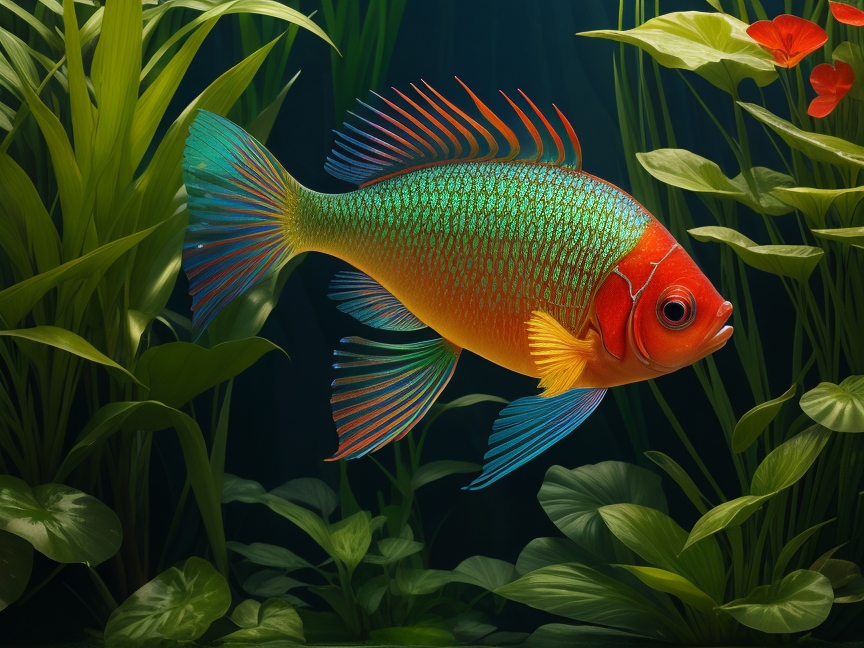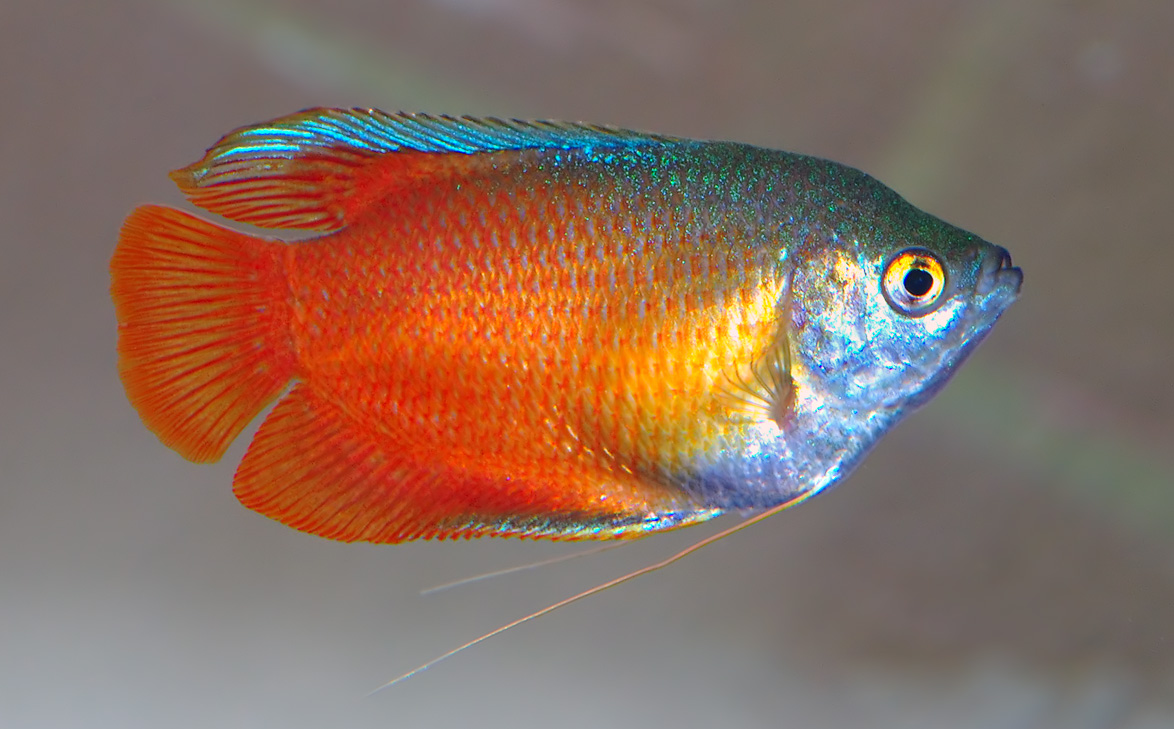If you’re looking for a colorful and vibrant addition to your aquarium, the Dwarf Gourami is the perfect choice. Known for its striking appearance and lively behavior, this fish is sure to captivate and entertain you.
In this article, we will explore the habitat, behavior, diet, and tips for keeping your Dwarf Gourami happy and healthy. Additionally, we will discuss the care and maintenance required to create an optimal environment for this fascinating aquatic creature.
Here are some quick facts about Dwarf Gouramis:
- Origin and Distribution: Dwarf Gouramis are native to India, West Bengal, Assam, and Bangladesh, and they are often found in thickly vegetated waters, along with other gourami species in the genus Trichogaster (also known as Colisa)13.
- Size: The average size of a Dwarf Gourami ranges from 3.5 to 4.5 inches, with males being slightly larger than females3.
- Colors and Markings: Male Dwarf Gouramis have a bright orange-red body with turquoise-blue, vertical stripes that extend into the fins. Females, on the other hand, remain a duller, silvery blue-gray color and never achieve the male’s brilliant colors13.
- Tank Size: A minimum tank size of 5 gallons is recommended for Dwarf Gouramis1.
- Diet: Dwarf Gouramis are omnivores and will eat algae, small bugs, larvae, and insects that settle on the surface of the water13.
- Breeding: Dwarf Gouramis are egglayers and create bubble nests for their eggs1.
- Care Level: Dwarf Gouramis are considered intermediate in terms of care requirements1.
- pH: The ideal pH range for Dwarf Gouramis is 6.0 to 7.51.
- Hardness: They can tolerate water hardness levels of 4 to 10 dGH1.
- Temperature: The recommended temperature range for Dwarf Gouramis is 72 to 82 F (22 to 28 C)1.
- Tank Setup: Provide plenty of vegetation, including floating plants that cover only part of the surface. Dwarf Gouramis are top and mid-dwellers and prefer a quiet location with
Types of Dwarf Gourami
There are several types of Dwarf Gourami, each with their own unique colors and characteristics. Here are some of the most popular types:
- Blue Dwarf Gourami
- Powder Blue Dwarf Gourami
- Neon Blue Dwarf Gourami
- Flame Dwarf Gourami
- Honey Dwarf Gourami
- Red Dwarf Gourami
Each of these variations has the same care requirements and temperament as the standard Dwarf Gourami, and they can also breed with each other with ease16. It’s worth noting that some of these color variations are the result of selective breeding over the past 50 years and do not appear in the wild6.
Habitat of Dwarf Gourami
In their natural habitat, dwarf gouramis prefer densely planted areas with plenty of hiding spots. These small freshwater fish thrive in tanks that mimic their natural environment.
For optimal housing, a tank size of at least 20 gallons is ideal. This size provides enough space for the gouramis to swim around comfortably while allowing for the inclusion of live plants and hiding places.
When it comes to compatibility with other fish, dwarf gouramis are generally peaceful but can become territorial during breeding. It’s recommended to keep them with similarly sized and peaceful species such as tetras, rasboras, or catfish.
Avoid housing them with aggressive or fin-nipping fish to prevent stress and potential harm to the dwarf gouramis.

Behavior of Dwarf Gourami
You’ll notice that the behavior of these fish varies depending on their environment and tank mates. Dwarf gouramis are generally peaceful and can coexist with other peaceful species. However, they can become aggressive towards their own kind, especially males of the same species. In a community tank, it’s best to keep only one male dwarf gourami to prevent aggression. They’re also known to be territorial and may display aggression towards other fish if they feel their space is being invaded.
When it comes to breeding habits, male dwarf gouramis are known for their elaborate courtship displays. They build bubble nests at the water’s surface and entice females to spawn in them. After spawning, the male guards the eggs and cares for the fry until they become free-swimming. It’s important to provide suitable hiding spots and floating plants in the tank to support the breeding behavior of dwarf gouramis.
Diet of Dwarf Gourami
To maintain the health of your fish, it’s important to provide a varied diet consisting of high-quality flakes, pellets, and live or frozen foods. Dwarf Gouramis have specific feeding habits and nutritional requirements that need to be met for their well-being. These beautiful fish are omnivorous, which means they eat both plant and animal matter. In the wild, they feed on small insects, crustaceans, and algae. When kept in captivity, it’s essential to replicate their natural diet as closely as possible. Here is a table outlining the feeding habits and nutritional requirements of Dwarf Gouramis:
| Feeding Habits | Nutritional Requirements |
|---|---|
| Omnivorous | High-quality protein |
| Plant matter | |
| Vitamins and minerals | |
| Omega-3 fatty acids |
Tips for Keeping Dwarf Gourami Happy and Healthy
Ensure that your fish is happy and healthy by following these tips.
- When it comes to dwarf gourami breeding, it’s essential to create the right environment. Provide a spacious tank with plenty of hiding places, such as plants and caves.
- Maintain a stable water temperature between 75-82°F and a pH level of 6.0-7.5.
- Offer a balanced diet consisting of high-quality pellets, live or frozen foods, and occasional vegetable matter.
- Regular water changes are crucial to prevent the buildup of harmful toxins.
- Additionally, be aware of common diseases in dwarf gourami, such as Dwarf Gourami Disease, bacterial infections, and parasitic infestations.
- Keep a close eye on their behavior, appetite, and physical appearance to catch any signs of illness early.
Care and Maintenance of Dwarf Gourami Aquarium
Care and Maintenance of Dwarf Gourami Aquarium
Dwarf gouramis are beautiful and peaceful fish that can thrive in a well-maintained aquarium. To keep your dwarf gouramis healthy and happy, you need to follow some basic care and maintenance tips.
Aquarium Setup
The first step is to provide your dwarf gouramis with a suitable aquarium setup. You should have a tank of at least 10 gallons, with a heater and a filter. The heater will keep the water temperature stable, while the filter will remove any harmful substances from the water.
The ideal water temperature for dwarf gouramis is between 76 and 82 degrees Fahrenheit, with a pH level of 6.0 to 7.5. You can use a thermometer and a pH test kit to monitor these parameters regularly. You should also add some plants and decorations to the tank to create hiding places and reduce stress for your fish.
Water Changes
The second step is to perform regular water changes to keep the water quality high. Water changes will remove any excess waste, food, or debris that can accumulate in the tank and cause ammonia, nitrite, or nitrate levels to rise. These chemicals can harm your fish and lead to diseases or death.
You should change about 20% to 25% of the water every two weeks, using a gravel vacuum to siphon out the dirty water from the bottom of the tank. You should also replace the filter media as needed, following the manufacturer’s instructions. When adding new water to the tank, make sure it is dechlorinated and has the same temperature and pH as the old water.
Dwarf Gouramis Tank Mates
Dwarf gouramis are peaceful fish that can be kept in community tanks with suitable tank mates. When choosing tank mates for dwarf gouramis, it is important to consider their similar environmental requirements and ensure there is enough space for all inhabitants to flourish harmoniously1. Some popular and compatible tank mates for dwarf gouramis include:
- Mollies1236
- Guppies126
- Platies3
- Swordtails3
- Neon Tetras24
- Chili Rasboras24
- Zebra Danios24
- Cory Cats4
- Ghost Catfish2
- Harlequin Rasboras4
- Plecos5
- Loaches5
- Catfish5
- Neon Blue Gourami5
These fish are small, peaceful, and have similar water parameter requirements, making them suitable companions for dwarf gouramis. It is also a good idea to provide ample hiding places, such as heavily planted tanks and floating plants, for the dwarf gouramis to feel secure2.
In conclusion, the dwarf gourami is a fascinating fish species that requires specific care and attention to thrive in an aquarium setting.
By providing a suitable habitat, monitoring their behavior, and offering a balanced diet, you can ensure the happiness and health of your dwarf gourami.
Regular care and maintenance of the aquarium are also essential to create a clean and stable environment for these beautiful fish.

